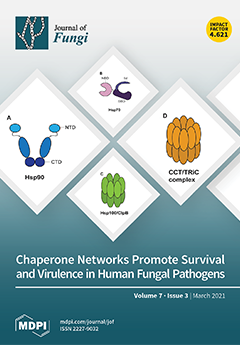Ibrexafungerp is a new orally-available 1,3-β-D-glucan synthesis inhibitor in clinical development. Its in vitro activity and that of amphotericin B, voriconazole, and micafungin were evaluated against a collection of 168 clinical isolates of
Aspergillus spp., including azole–susceptible and azole–resistant (Cyp51A mutants)
Aspergillus fumigatus
[...] Read more.
Ibrexafungerp is a new orally-available 1,3-β-D-glucan synthesis inhibitor in clinical development. Its in vitro activity and that of amphotericin B, voriconazole, and micafungin were evaluated against a collection of 168 clinical isolates of
Aspergillus spp., including azole–susceptible and azole–resistant (Cyp51A mutants)
Aspergillus fumigatus sensu stricto (
s.s.) and cryptic species of
Aspergillus belonging to six species complexes showing different patterns of antifungal resistance, using EUCAST and CLSI antifungal susceptibility testing reference methods. Ibrexafungerp displayed low geometric means of minimal effective concentrations (MECs) against
A. fumigatus s.s. strains, both azole susceptible (0.040 mg/L by EUCAST and CLSI versus 1.231 mg/L and 0.660 mg/L for voriconazole, respectively) and azole resistant (0.092 mg/L and 0.056 mg/L, EUCAST and CLSI, while those for voriconazole were 2.144 mg/L and 2.000 mg/L). Ibrexafungerp was active against most of the cryptic species of
Aspergillus tested, yielding MEC values only comparable to those of micafungin. Nevertheless, this new compound exhibited a moderate activity against
A. ustus complex species, MECs ≥ 0.5 mg/L against
Aspergillus insuetus and
Aspergillus keveii strains, and was inactive against the
Aspergillus alliaceus isolates tested (MEC
90s ≥ 16 mg/L). All in all, ibrexafungerp shows encouraging in vitro results against cryptic species of
Aspergillus and azole–susceptible and azole resistant strains of
A. fumigatus, some of which are difficult to treat using the available therapeutic options.
Full article






